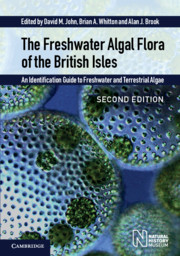 The Freshwater Algal Flora of the British Isles
The Freshwater Algal Flora of the British Isles Book contents
- Frontmatter
- Contents
- The online material (formerly provided in DVD format)
- List of Contributors
- Foreword
- Preface
- Acknowledgements
- Introduction
- Distribution and Ecology
- History of Freshwater Algal Studies in the British Isles
- Field Methods
- Laboratory Methods
- Water Framework Directive
- Cultures of British Freshwater Algae
- Classification
- Key to phyla
- Cyanobacteria (Cyanophyta)
- Phylum Rhodophyta (Red Algae)
- Phylum Euglenophyta (Euglenoids)
- Phylum Cryptophyta (Cryptomonads)
- Phylum Dinophyta (Dinoflagellates)
- Phylum Raphidophyta
- Phylum Haptophyta (Prymnesiophyta)
- Phylum Chrysophyta (Golden Algae)
- Phylum Xanthophyta (Tribophyta) (Yellow-Green Algae)
- Phylum Eustigmatophyta
- Phylum Bacillariophyta (Diatoms)
- Phylum Phaeophyta (Brown Algae)
- Primitive Green Algae (‘PRASINOPHYTA’)
- Phylum Chlorophyta (Green Algae)
- Phylum Glaucophyta
- Glossary
- Standard Form of Authors of Algal Names
- Sources of Illustrations or Material
- References
- Taxonomic Index
- Subject Index
- Plate Saction
- Miscellaneous Endmatter
- Miscellaneous Endmatter
Distribution and Ecology
Published online by Cambridge University Press: 12 January 2024
- Frontmatter
- Contents
- The online material (formerly provided in DVD format)
- List of Contributors
- Foreword
- Preface
- Acknowledgements
- Introduction
- Distribution and Ecology
- History of Freshwater Algal Studies in the British Isles
- Field Methods
- Laboratory Methods
- Water Framework Directive
- Cultures of British Freshwater Algae
- Classification
- Key to phyla
- Cyanobacteria (Cyanophyta)
- Phylum Rhodophyta (Red Algae)
- Phylum Euglenophyta (Euglenoids)
- Phylum Cryptophyta (Cryptomonads)
- Phylum Dinophyta (Dinoflagellates)
- Phylum Raphidophyta
- Phylum Haptophyta (Prymnesiophyta)
- Phylum Chrysophyta (Golden Algae)
- Phylum Xanthophyta (Tribophyta) (Yellow-Green Algae)
- Phylum Eustigmatophyta
- Phylum Bacillariophyta (Diatoms)
- Phylum Phaeophyta (Brown Algae)
- Primitive Green Algae (‘PRASINOPHYTA’)
- Phylum Chlorophyta (Green Algae)
- Phylum Glaucophyta
- Glossary
- Standard Form of Authors of Algal Names
- Sources of Illustrations or Material
- References
- Taxonomic Index
- Subject Index
- Plate Saction
- Miscellaneous Endmatter
- Miscellaneous Endmatter
Summary
Introduction
Algae are almost ubiquitous in waters capable of supporting photosynthetic life and no body of water in the British Isles has been reported to have conditions extreme enough to prevent algal growth. Providing some moisture is present, at least intermittently, then algae can also grow in a wide range of terrestrial habitats. Not surprisingly, such algae are much more conspicuous in the wetter parts of the region. A few algae, such as the algal components of lichens and several widespread microorganisms, are symbionts. Some algae are large enough to be treated as macrophytes (see Glossary, p. 768). The charophyte Chara hispida (Plate 2E), for instance, often exceeds 1m in length. On the other hand, the great majority of species are microscopic and visible to the naked eye only when their numbers are large enough to discolour the water or form obvious surface growths. The type of habitat and size of the organisms determine what sort of method is best for collecting samples.
The algae living in the water column of lakes and larger rivers – the phytoplankton – have been studied for a long time. This is partly because of their ecological importance, but also because the larger species are easy to sample with a net and are also often attractive organisms to observe. However, the smaller species are more of a problem to sample (see Methods). Descriptive accounts of lake phytoplankton have divided the organisms into size classes, although the limits and terms for these classes have not always been the same. The net plankton are the largest planktonic algae to be retained in fine mesh nets (<60 μm across). The picoplankton are less than 2 μm in any dimension, while the nannoplankton occupy the next largest size range. Freshwater algal researchers have usually adopted 20 μm as the upper limit, but the literature sometimes adopts much higher values, typically 60 or 80 μm. Some species of phytoplankton are present in the water column throughout the year, although they may vary markedly in abundance according to the season. Other species exist for part of the year on bottom sediments or are associated with plant growths in shallower parts of the water body. Some planktonic algae are confined to the marginal shallows, where they are normally associated with submerged higher plant vegetation (metaplankton). The flora associated with Myriophyllum spicatum is often especially rich.
- Type
- Chapter
- Information
- The Freshwater Algal Flora of the British IslesAn Identification Guide to Freshwater and Terrestrial Algae, pp. 6 - 8Publisher: Cambridge University PressPrint publication year: 2021
